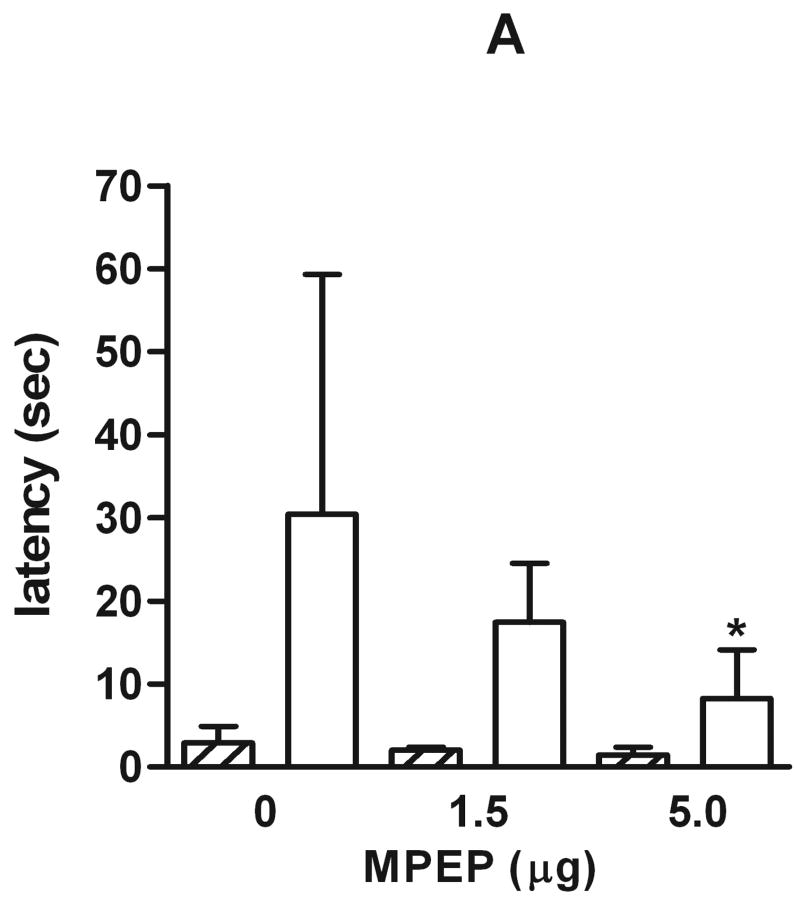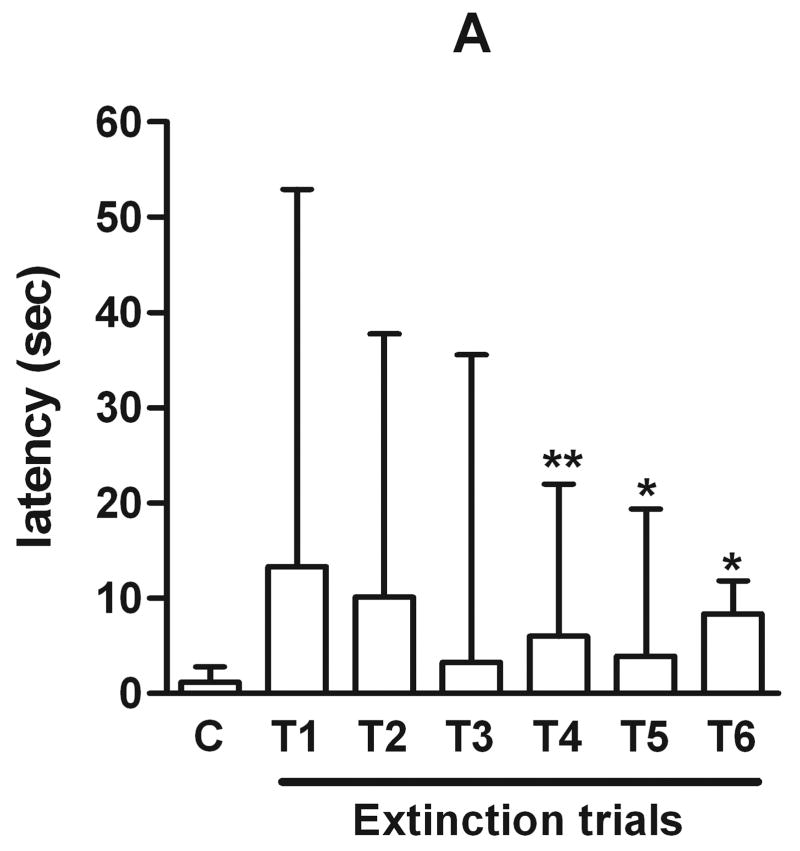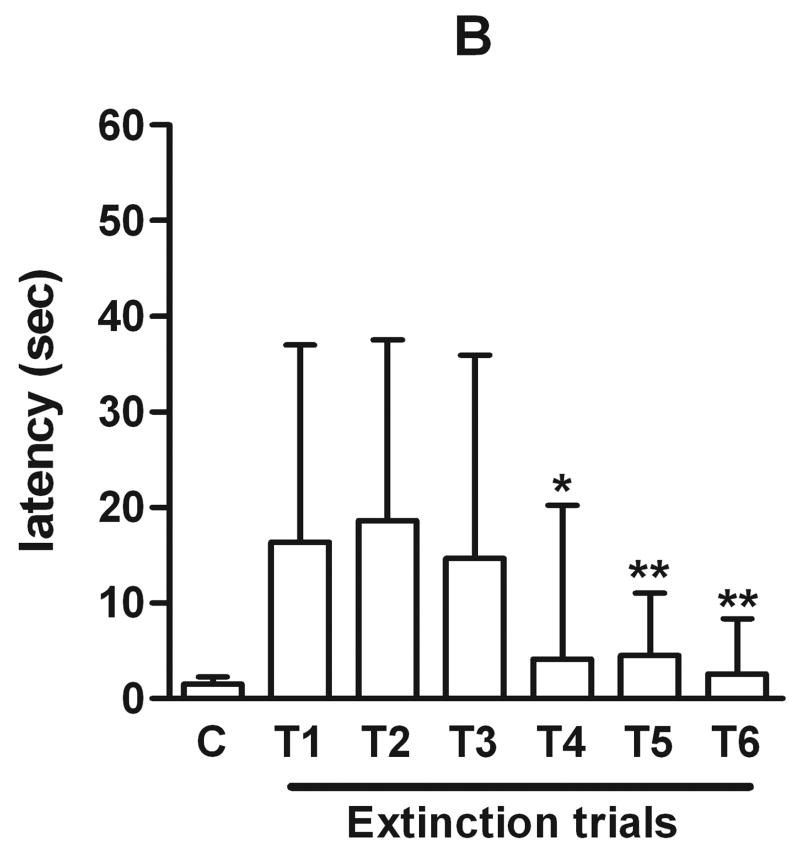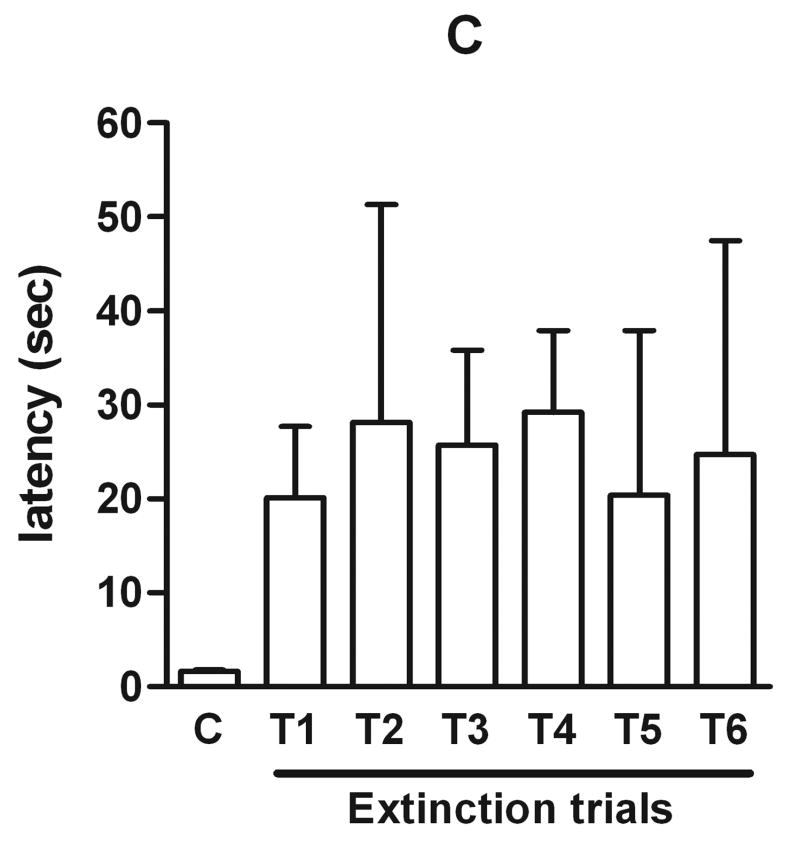Abstract
Group I metabotropic glutamate receptors (mGlu1 and 5) have been implicated in synaptic plasticity and learning and memory. However, much of our understanding of how these receptors in different brain regions contribute to distinct memory stages in different learning tasks remains incomplete. The present study investigated the effects of the mGlu5 receptor antagonist, 2-methyl-6-(phenylethynyl)-pyridine (MPEP), and mGlu1 receptor antagonist, (S)-(+)-α-amino-4-carboxy-2-methylbenzene-acetic acid (LY 367385) in the dorsal hippocampus on the consolidation and extinction of memory for inhibitory avoidance learning. Male, Sprague-Dawley rats were trained in a single-trial step-down inhibitory avoidance task. MPEP, LY 367385 or saline were infused bilaterally into the CA1 region immediately after training or immediately after the first retention test which was given 24 hr after training. Rats receiving MPEP (1.5 or 5.0 μg/side) or LY 367385 (0.7 or 2.0 μg/side) infusion exhibited a dose-dependent decrease in retention when tested 24 hr later. MPEP was ineffective while LY 367385 significantly attenuated extinction when injected after the first retention test using an extinction procedure. These findings indicate a selective participation of hippocampal group I mGlu receptors in memory processing in this task.
Keywords: metabotropic glutamate receptor, passive avoidance, hippocampus, extinction, consolidation, mGlu5 receptor antagonist, mGlu1 receptor antagonist
1. Introduction
Group I mGlu receptors (mGlu1 and mGlu5) are G-protein coupled receptors linked to different ion channels and a variety of intracellular signaling pathways (Conn, & Pin, 1997; Hermans, & Challiss, 2001). Involvement of group I mGlu receptors in the formation of long-term memories in rodents has been well documented (reviewed by Riedel, Platt, & Micheau, 2003; Simonyi, Schachtman, & Christoffersen, 2005). The evaluation of the effects of mGlu5-selective antagonists in various behavioral paradigms has concluded that mGlu5 receptors play a critical role in aversive learning tasks and in hippocampal-dependent spatial learning. MGlu5 receptor has been found to be important in fear conditioning, passive avoidance, conditioned taste aversion, and Y-maze, radial arm maze, Morris water maze performance (Balschun, & Wetzel, 2002; Gravius, Pietraszek, Schäfer, Schmidt, & Danysz, 2005; Gravius, Barberi, Schäfer, Schmidt, & Danysz, 2006; Naie, & Manahan-Vaughan, 2004; Rodrigues, Bauer, Farb, Schafe, & LeDoux, 2002; Schachtman, Bills, Ghinescu, Murch, Serfozo, & Simonyi, 2003; Schulz, Fendt, Gasparini, Lingenhöhl, Kuhn, & Koch, 2001) but are not required in certain other learning tasks such as the delayed match to position test or a three-hole spatial learning task (Ballard, Woolley, Prinssen, Huwyler, Porter, & Spooren, 2005; Petersen, Bomme, Baastrup, Kemp, & Christoffersen, 2002). In contrast, studies using mGlu1-selective antagonists have been less frequent, although a role for mGlu1 receptors in spatial memory has been established in several studies using the radial arm maze, Morris water maze, contextual fear conditioning, passive avoidance and an appetitive spatial three-choice test (Christoffersen, Christensen, Hammer, & Vang, 1999a; Christoffersen, Christensen, Harrington, Macphail, & Riedel, 1999b; Gravius et al., 2005, 2006; Maciejak, Taracha, Lehner, Szyndler, Bidzi ski, Skórzewska, Wislowska, Zienowicz, & Pla nik, 2003; Naie, & Manahan-Vaughan, 2005; Ohno, & Watanabe, 1998; Riedel, Sandager-Nielsen, & Macphail, 2002; Steckler, Oliveira, Van Dyck, Van Craenendonck, Mateus, Langlois, Lesage, & Prickaerts, 2005).
Inhibitory/passive avoidance learning is a hippocampus-dependent associative learning task which is a widely used model to study memory processes (Gold, 1986). In rodents, two forms of passive/inhibitory avoidance are frequently used: the step-down and the step-through avoidance tests. In both avoidance tasks, one or a few trials are sufficient to induce memory lasting for weeks or months, allowing good stimulus control, and permitting the separation of drug-induced effects on different memory stages. In recent years, attempts have been made to identify the molecular mechanisms underlying memory processes in passive avoidance learning; and the involvement of many neurotransmitters, receptors, ion channels and signaling molecules has been characterized (Izquierdo, & McGaugh, 2000; Izquierdo, Bevilaqua, Rossato, Bonini, Medina, & Cammarota, 2006). With respect to group I mGlu receptors, recent studies have used systemically active, subtype-specific antagonists (Kew, & Kemp, 2005). The newest mGlu5-selective antagonist 3-[(2-methyl-1,3-thiazol-4yl)ethynyl]pyridine (MTEP, 2.5, 5, or 10 mg/kg i.p.) was given during acquisition and the highest dose was shown to impair long-term retention measured 24 hr later (Gravius et al., 2005). Our earlier work using systemic administration of another mGlu5 antagonist, 2-methyl-6-(phenylethynyl)-pyridine (MPEP, 3 or 10 mg/kg i.p.), 60 minutes before training also obtained a similar impairment (Simonyi et al., 2005). A one trial step-down inhibitory avoidance procedure was applied, and MPEP at the 10 mg/kg dose significantly reduced latencies at the retention test 24 hr after training without influencing step-down latencies during training. The mGlu1-selective antagonist (3-ethyl-2-methyl-quinolin-6-yl)-(4-methoxy-cyclohexyl)-methanone methanesulfonate (EMQMCM, 5 mg/kg i.p.) impaired retention when given 30 min before training or before testing but the post-training injection was ineffective, and the authors ruled out any state-dependent effect (Gravius et al., 2005). To date, these highly selective, subtype-specific antagonists have not been used in extinction studies and since they are systemically active, available data are very limited on their local effects.
Memory consolidation refers to distinct postacquisition processes that stabilize long-term memory as well as that of a memory state during which memory stabilization occurs (Dudai, 2004; McGaugh, 2000). It is assumed that in addition to posttranslational modifications of specific proteins, changes in gene expressions, de novo protein synthesis and synaptic rearrangements are essential to long-term memory formation at the cellular level (Dudai, 2002; Dudai, & Morris, 2000). The molecular mechanisms involved in consolidation are region- and/or task-specific. Although these processes have been studied extensively, much less is known about extinction, which is defined as a decline in the frequency or intensity of the conditioned response when the conditioned stimulus (CS) is presented without the unconditioned stimulus (US) (Delamater, 2004; Myers, & Davis, 2002; Pavlov, 1927). Several lines of evidence suggest that extinction is a form of learning that involves the formation of a new association between the CS and no-US (Myers, & Davis, 2002). Previous investigations have shown that long-term memory for extinction involves some similar but also different mechanisms from those that lead to consolidation of initial conditioning (Cammarota, Bevilaqua, Barros, Vianna, Izquierdo, Medina, & Izquierdo, 2005; Myers, & Davis, 2002; Suzuki, Josselyn, Frankland, Masushige, Silva, & Kida, 2004). However, considerable evidence indicates that the hippocampus is involved in both consolidation and extinction of inhibitory avoidance learning (Cammarota et al., 2005; Szapiro, Vianna, McGaugh, Medina, & Izquierdo, 2003). The present study was designed to investigate the effects of intrahippocampal infusion of mGlu1- and mGlu5-selective antagonists on these processes.
2. Materials and methods
2.1. Animals
Male, Sprague-Dawley rats (Harlan, Indianapolis, IN) weighing 220–240 g were housed individually with a 12 hr light/12 hr dark cycle (time on at 6:00 AM). Food and water were available ad libitum. Experiments were initiated near the beginning of the light period between 10:00 and 11:00 AM. In all experiments, animals were randomly assigned to groups (n=8–11). All experiments were conducted blind to the treatment condition of the rat. The work was carried out in accordance with National Institutes of Health guidelines and with permission from the University of Missouri-Columbia Animal Care and Use Committee (Protocol #3600).
2.2. Animal surgery and drug infusion
Rats were given one week to acclimate to the vivarium before surgery. The rats were anesthetized with 87 mg/kg ketamine and 13 mg/kg xylazine (i.p.) and placed in a stereotactic apparatus (Kopf Instruments, Tujunga, CA). Twenty-six gauge stainless steel guide cannulas (C315G, Plastics One, Roanoke, VA) were implanted bilaterally into the CA1 region of the hippocampus. The stereotaxic coordinates were: A −4.3, L ±3.6, V −2.6 mm (Paxinos and Watson 1998). A stylus was placed in the guide cannula to prevent clogging. After surgery, a 1-week recovery period was allowed. Injections were made in a volume of 0.5 μl/side over 1 min via injection pump using 33 gauge infusion cannulas that extended 1 mm from the base of the guide. The injection cannulas were left in position for an additional one min to minimize dragging of the drugs along the injection tract.
2.3. Behavioral procedures
Animals were handled daily for one week before the experiment, and were habituated to the apparatus by placing them in the shuttle box (Med Associates, St. Albans, VT) for 3 minutes 24 hr before the training trial. The rats were not placed on the platform during exploration, but they were able to step on and off the platform during the exploration period. On the conditioning day, animals were placed on the 2.5-cm high, 8-cm wide platform (ENV-010 MSD, Med Associates) in the shuttle-box. The grid floor was connected to a scrambled shock generator. The detection system consisted of six pairs of photobeams, located 3.5 cm above the floor. The system was remotely controlled through an interface connected to an IBM-PC operating Med Associates software (version SOF-700RA-11). Latency to step down onto the grid was measured. Upon stepping down, the animals received a 0.4 mA, 0.5 sec footshock and were removed from the shuttle box. The mGlu5 receptor selective antagonist MPEP (Tocris, Ellisville, MO) was infused in a dose of 1.5 and 5.0 μg/0.5 μl/side while the mGlu1 receptor selective antagonist (S)-(+)-α-amino-4-carboxy-2-methylbenzene-acetic acid (LY 367385, Tocris, Ellisville, MO) was used in a dose of 0.7 and 2.0 μg/0.5 μl/side. Doses were chosen based on EC50 values and effective doses shown in other behavioral studies (Kew, & Kemp, 2005; Naie, & Manahan-Vaughan, 2005; Perez de la Mora, Lara-Garcia, Jacobsen, Vazquez-Garcia, Crespo-Ramirez, Flores-Garcia, Escamilla-Marvan, & Fuxe, 2006). The infusion occurred immediately after the conditioning trial. Control rats received saline. The animals were wrapped in a towel and held gently by the experimenters during the infusion procedure. The animals were habituated to this procedure after preexposure to the shuttle box the day before conditioning. The retention test occurred 24 hr after training. The test session was identical to the training session except that the footshock was omitted. Step-down latency was recorded with a maximum latency of 180 sec.
The procedure for the experiment examining extinction consisted of the same training (except that a 0.5 mA, 1 sec footshock was used and infusion did not occur after conditioning) followed by the retention test as used in the experiment described above. Immediately after the retention test which served as the first extinction trial (24 hr after conditioning), MPEP or LY 367385 (the effective dose in our earlier experiment) was infused into the CA1. Controls received saline. Animals were returned in their home cages. They were then tested for retention 24, 48, 72, 96 and 120 hr after this initial extinction trial (i.e., extinction test trials 2 – 6). This procedure was found to be effective in previous studies using the same behavioral task (Szapiro et al., 2003).
2.4. Histological verification
Upon completion of the experiments, the rats were infused with 0.5 μl toluidine blue. Thirty min later, the animals were anesthetized with isoflurane and decapitated. The brains were removed, and frozen on dry ice. The cannula placement was determined by examination of subsequent coronal sections (25 μm) stained with cresyl violet. The sections were examined under light microscope, and the site of the injection was confirmed using the standardized atlas plates of Paxinos and Watson (1998). Based on studies in other laboratories, under these conditions, the injectate did not go beyond 1 mm of the infusion site (see Corcoran, Desmond, Frey, & Maren, 2005; Martin, 1991).
2.5. Statistical analysis
Because step-down latencies are not normally distributed, results are expressed as median and interquartile range. Logarithm transformation was applied to normalize latencies to permit parametric analyses. Data were analyzed either by one-way analysis of variance (ANOVA) or by two-way repeated measures ANOVA followed by pairwise comparisons using Bonferroni’s test. P values of <0.05 were considered statistically significant.
3. Results
3.1. Histology
Figure 1 shows a representative photomicrograph of a needle track terminating in the hippocampus. Animals with improper injection needle placements were excluded from further analysis.
Figure 1.
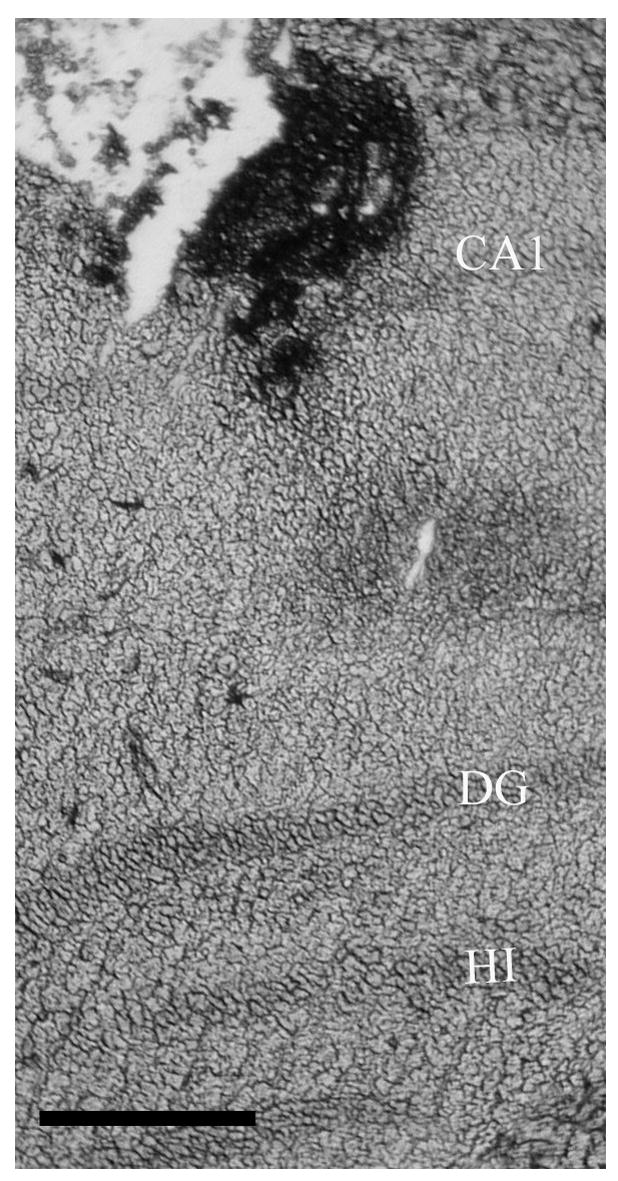
Representative photomicrograph of the needle track terminating in the hippocampal CA1 region (scale bar = 500 μm). DG, dentate gyrus; HI, hilus.
3.2. Effect of mGlu1 and mGlu5 receptors on consolidation of inhibitory avoidance
Training latencies and retention latencies of animals given MPEP (1.5 or 5.0 μg) or saline infusion into the hippocampal CA1 region immediately after training of inhibitory avoidance are shown in Figure 2A. There were no significant differences in training latencies. One-way ANOVA revealed a significant effect of MPEP on test latencies (F2,27= 4.008, p=0.0299). The retention latencies of rats given intrahippocampal infusions of 5.0 μg MPEP were significantly shorter than those of saline controls (p<0.05, Bonferroni’s Multiple Comparison Test). The latencies observed with this shock intensity and duration were consistent with those reported in previous studies (Izquierdo, Schroder, Netto, & Medina, 1999).
Figure 2.
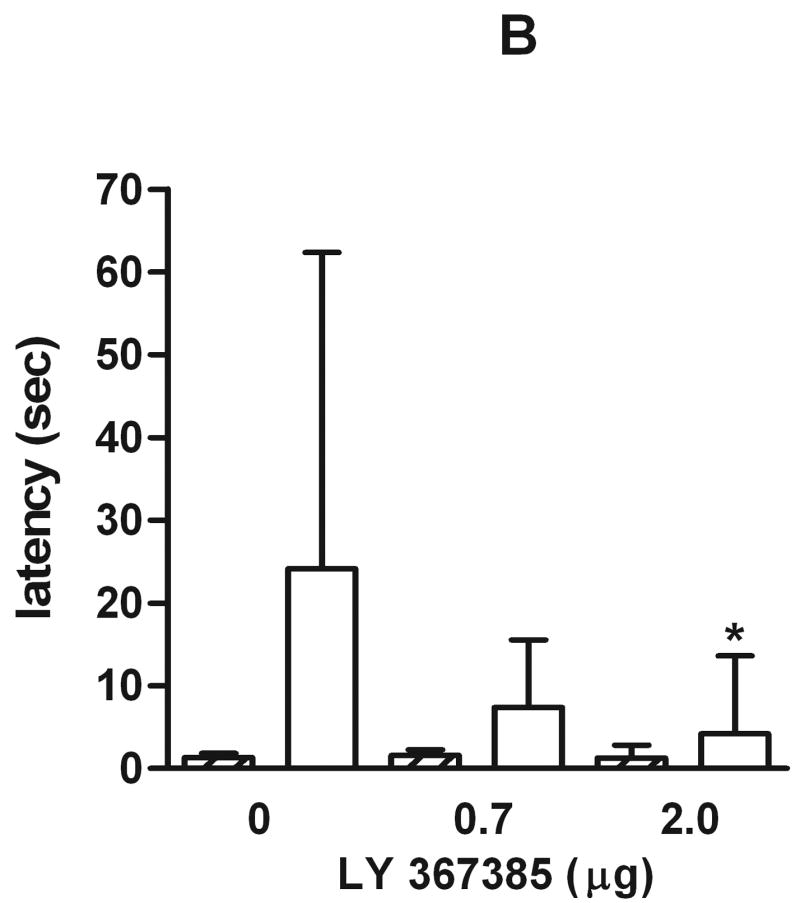
Effect of MPEP and LY 367385 on inhibitory avoidance consolidation. (A) Saline (n=11) or MPEP (1.5 μg, n=9 or 5.0 μg, n=10) was infused into the CA1 region immediately after training. (B) Saline (n=9) or LY 367385 (0.7 μg, n=8 or 2.0 μg, n=10) was infused into the CA1 region immediately after training. Retention was tested 24 hr after training. The figure depicts the latencies during training (shaded bars) and test (open bars). Results represent the median and interquartile range. *p<0.05 compared to saline (One-way ANOVA followed by Bonferroni’s Multiple Comparison Test).
Training latencies and retention latencies of animals given LY 367385 (0.7 or 2.0 μg) or saline infusion into the hippocampal CA1 region immediately after inhibitory avoidance training are shown in Figure 2B. There were no significant differences in training latencies but a significant effect of LY 367385 on test latencies was found (F2,23= 3.979, p=0.0328). The retention latencies of rats given intrahippocampal infusions of 2.0 μg LY 367385 were significantly shorter than those of saline controls (p<0.05, Bonferroni’s Multiple Comparison Test).
3.3 Effect of mGlu1 and mGlu5 receptors on extinction of inhibitory avoidance
Figure 3 shows the training latencies and retention latencies of animals given saline (Fig. 3A), 5.0 μg MPEP (Fig. 3B) or 2.0 μg LY 367385 (Fig. 3C) infusion into the hippocampal CA1 region immediately after the first extinction trial (T1) which also served as a 24-hr retention test, and the retention scores for the five final extinction sessions (T2–T6). There were no significant differences either in training latencies or retention latencies at 24 hr. Similar to other studies, extinction became detectable only after several test sessions using similar procedures to the present one (Izquierdo et al., 1999; Roldan, Cobos-Zapiain, Quirarte, & Prado-Alcala, 2001; Sanchez-Alavez, Gomez-Chavarin, Navarro, Jimenez-Anguiano, Murillo-Rodriguez, Prado-Alcala, Drucker-Colin, & Prospero-Garcia, 2000). Two-way repeated measures ANOVA of saline and MPEP data revealed no significant main effects or an interaction of drugs across trials. A significant effect of time (F5,95=9.78, p<0.0001) was found and Bonferroni posttests revealed that reduction in step-down latencies reached statistical significance at 96 hr after conditioning on the fourth extinction trial as compared to the first extinction trial in both saline- and MPEP-treated groups. MPEP did not influence extinction. The analysis of saline and LY 367385 data revealed a significant interaction between drug conditions across trials (F5,85=2.42, p=0.0422); LY 367385 attenuated extinction.
Figure 3.
Effect of MPEP and LY 367385 on inhibitory avoidance extinction. Saline (A, n=10), 5.0 μg MPEP (B, n=11) or 2.0 μg LY 367385 (C, n=9) was infused into the CA1 region immediately after the first extinction trial (T1) which also served as a retention test and occurred 24 hr after conditioning (C). Five extinction test trials were administered (one per day) for five successive days (T2–T6). Results are expressed as median and interquartile range. *p<0.05, **p<0.01 compared to the first extinction trial (Two-way repeated measures ANOVA followed by Bonferroni posttests).
4. Discussion
The main findings of the present study were that post-training intrahippocampal infusion of either an mGlu1 or an mGlu5 receptor antagonist resulted a dose-dependent decrease in retention of inhibitory avoidance when tested 24 hr later indicating the importance of group I mGlu receptors in memory consolidation. Furthermore, the mGlu1 receptor antagonist but not the mGlu5 receptor antagonist attenuated the rate of extinction demonstrating the unique contribution of mGlu1 receptors in processes underlying memory extinction of the inhibitory avoidance response. As mentioned, extinction appears to be a form of learning that involves the formation of a new association between the CS and no-US (Myers, & Davis, 2002). It cannot be stated with certainty whether LY 367385 administered on the first extinction trial slowed the rate of extinction by hindering the formation of the potential new association that is acquired during extinction, or enhanced the strength of the conditioning memory; but it seems likely that a drug treatment administered long after conditioning was completed would impact extinction learning rather than processing of the CS-US association. The present results add to an understanding of the neurobiology of inhibitory avoidance learning and, together with other published findings, suggest that the molecular mechanisms of extinction are distinct from those underlying consolidation. Inhibitory avoidance consolidation but not extinction depends on ERK1/2 phosphorylation in the basolateral amygdala and the entorhinal cortex (Vianna, Coitinho, & Izquierdo, 2004). Changes in gene expression are different after fear conditioning and extinction in the amygdala (Chhatwal, Myers, Ressler, & Davis, 2005). Recent studies using pharmacology or mouse genetics have identified two genes (cannabinoid receptor 1 and L-type voltage-gated calcium channel) that may be required for extinction but not for initial memory consolidation in fear conditioning (Cain, Blouin, & Barad, 2002; Marsicano, Wotjak, Azad, Bisogno, Rammes, Cascio, Hermann, Tang, Hofmann, Zieglgansberger, Di Marzo, & Lutz, 2002; Suzuki et al., 2004). In another learning task, conditioned taste aversion, activation of NMDA receptors and ERK1/2 phosphorylation in the insular cortex are required for consolidation but not for extinction (Berman, & Dudai, 2001). On the other hand, consolidation and extinction share some common mechanisms such as the dependence on second messenger systems such as the MAPK and PKA cascades (Cammarota et al., 2005; Izquierdo et al., 2006). Likewise, activation of NMDA and mGlu1 receptors in the hippocampus is required for both consolidation and extinction of inhibitory avoidance (Bianchin, Da Silva, Schmitz, Medina, & Izquierdo, 1994; Szapiro et al., 2003). The temporal dynamics of memory processing has been the focus of many investigations, and it seems that region-specific as well as behavioral task-specific mechanisms exist.
The mechanisms by which group I mGlu receptors influence memory processing in inhibitory avoidance and other types of fear-based learning tasks are clearly not fully delineated. Considering pharmacological studies, most drugs today have high bioavailability and are therefore systemically applied. However, systemic injection cannot support any anatomical hypothesis about the sites at which group I mGlu receptor antagonists have their effect on fear memory processing, and only a few studies have used local drug infusion. These results, in combination with the results of the present study, point to the involvement of the amygdala and the hippocampus. For example, 2-amino-3-phosphonopropionic acid (AP3), a group I mGlu receptor antagonist, impaired memory consolidation when given into the CA1 area or the basolateral amygdala but not into the entorhinal or cingulate cortices immediately after conditioning in an inhibitory avoidance task (Bonini, Rodrigues, Kerr, Bevilaqua, Cammarota, & Izquierdo, 2003). Posttraining intrahippocampal infusion of an mGlu1 but not a mGlu5 receptor antagonist has been shown to increase freezing when measured 24 hour later in a contextual fear conditioning procedure (Maciejak et al., 2003). Amygdalar mGlu5 receptors are also implicated in fear acquisition. MPEP infusion into the lateral nucleus of the amygdala before conditioning attenuated fear-potentiated startle and both cue and contextual fear conditioning (Fendt, & Schmid, 2002; Rodrigues et al., 2002). With respect to glutamate neurotransmission in general, NMDA, AMPA and mGlu receptors have all been shown to be involved in the processing of fear memories, and particularly in inhibitory avoidance (see Izquierdo et al., 2006 for a review).
Consistent with previous in vitro and in vivo reports, the present results suggest that mGlu1 and mGlu5 receptors play different roles in the hippocampus, exhibiting a high degree of functional segregation in the same neuronal population. First of all, mGlu1 and mGlu5 receptors show distinct localization in the hippocampus. MGlu5 receptor is expressed in all principal cells but especially high in CA1 neurons (Romano, Sesma, McDonald, O’Malley, Van Den Pol, & Olney, 1995). MGlu1alpha receptor-immunoreactivity is restricted to non-principal neurons in all hippocampal fields, whereas mGlu1beta receptor-immunoreactivity is strongest in principal cells of the CA3 field and dentate granule cells but absent in CA1 (Ferraguti, Conquet, Corti, Grandes, & Knopfel, 1998). Moreover, mGlu5 but not mGlu1 receptor potentiates NMDA currents in the hippocampal CA1 region (Doherty, Palmer, Henley, Collingridge, & Jane, 1997; Mannaioni, Marino, Valenti, Traynelis, & Conn, 2001). The two receptors are differentially involved in LTP/LTD in CA1 region (Francesconi, Cammalleri, & Sanna, 2004; Hou, & Klann, 2004; Naie, & Manahan-Vaughan, 2005). There are also some differences in G-protein coupling and signaling pathways between mGlu1 and mGlu5 receptors (Hermans, & Challiss, 2004; O’Riordan, Huang, Pizzi, Spano, Boroni, Egli, Desai, Fitch, Malone, Ahn, Liou, Sweatt, & Levenson, 2006). These differences may explain the selective participation of hippocampal mGlu1 and mGlu5 receptors in inhibitory avoidance memory processing. In line with this conclusion, a study has shown that mGlu5 receptor expression is transiently increased during fear memory consolidation in distinct hippocampal subregions while mGlu1 receptor expression did not change (Riedel, Casabona, Platt, Macphail, & Nicoletti, 2000). On the other hand, the influence of the mGlu1 receptor on GABAergic and cannabinoid transmission in the hippocampus may underlie its contribution to extinction processes (Battaglia, Bruno, Pisani, Centonze, Catania, Calabresi, & Nicoletti, 2001; Bordi, Reggiani, & Conquet, 1997; Chevaleyre & Castillo, 2003; Naie, & Manahan-Vaughan, 2005). In conclusion, this is the first demonstration of the effect of selective inhibition of hippocampal mGlu1 and mGlu5 receptors in inhibitory avoidance performance; the mGlu5 receptor is required for consolidation, while the mGlu1 receptor contributes to both consolidation and extinction in this task.
Acknowledgments
Supported by R03 MH64486-01A1 from the National Institute of Mental Health to AS.
Footnotes
Publisher's Disclaimer: This is a PDF file of an unedited manuscript that has been accepted for publication. As a service to our customers we are providing this early version of the manuscript. The manuscript will undergo copyediting, typesetting, and review of the resulting proof before it is published in its final citable form. Please note that during the production process errors may be discovered which could affect the content, and all legal disclaimers that apply to the journal pertain.
References
- Ballard TM, Woolley ML, Prinssen E, Huwyler J, Porter R, Spooren W. The effect of the mGlu5 receptor antagonist MPEP in rodent tests of anxiety and cognition: a comparison. Psychopharmacology. 2005;179:218–229. doi: 10.1007/s00213-005-2211-9. [DOI] [PubMed] [Google Scholar]
- Balschun D, Wetzel W. Inhibition of mGluR5 blocks hippocampal LTP in vivo and spatial learning in rats. Pharmacology Biochemistry & Behavior. 2002;73:375–380. doi: 10.1016/s0091-3057(02)00847-x. [DOI] [PubMed] [Google Scholar]
- Battaglia G, Bruno V, Pisani A, Centonze D, Catania MV, Calabresi P, Nicoletti F. Selective blockade of type-1 metabotropic glutamate receptors induces neuroprotection by enhancing gabaergic transmission. Molecular and Cellular Neuroscience. 2001;17:1071–1083. doi: 10.1006/mcne.2001.0992. [DOI] [PubMed] [Google Scholar]
- Berman DE, Dudai Y. Memory extinction, learning anew, and learning the new: dissociations in the molecular machinery of learning in cortex. Science. 2001;291:2417–2419. doi: 10.1126/science.1058165. [DOI] [PubMed] [Google Scholar]
- Bianchin M, Da Silva RC, Schmitz PK, Medina JH, Izquierdo I. Memory of inhibitory avoidance in the rat is regulated by glutamate metabotropic receptors in the hippocampus. Behavioural Pharmacology. 1994;5:356–359. doi: 10.1097/00008877-199406000-00014. [DOI] [PubMed] [Google Scholar]
- Bonini JS, Rodrigues L, Kerr DS, Bevilaqua LRM, Cammarota M, Izquierdo I. AMPA/kainate and group-I metabotropic glutamate receptor antagonists infused into different brain areas impair memory formation of inhibitory avoidance learning in rats. Behavioural Pharmacology. 2003;14:161–166. doi: 10.1097/00008877-200303000-00008. [DOI] [PubMed] [Google Scholar]
- Bordi F, Reggiani A, Conquet F. Regulation of synaptic plasticity by mGluR1 studied in vivo in mGluR1 mutant mice. Brain Research. 1997;761:121–126. doi: 10.1016/s0006-8993(97)00320-x. [DOI] [PubMed] [Google Scholar]
- Cain CK, Blouin AM, Barad M. L-type voltage-gated calcium channels are required for extinction, but not for acquisition or expression, of conditioned fear in mice. Journal of Neuroscience. 2002;22:9113–9121. doi: 10.1523/JNEUROSCI.22-20-09113.2002. [DOI] [PMC free article] [PubMed] [Google Scholar]
- Cammarota M, Bevilaqua LRM, Barros DM, Vianna MRM, Izquierdo LA, Medina JH, Izquierdo I. Retrieval and extinction of memory. Cellular and Molecular Neurobiology. 2005;25:465–474. doi: 10.1007/s10571-005-4009-z. [DOI] [PMC free article] [PubMed] [Google Scholar]
- Chevaleyre V, Castillo PE. Heterosynaptic LTD of hippocampal GABAergic synapses: a novel role of endocannabinoids in regulating excitability. Neuron. 2003;38:461–472. doi: 10.1016/s0896-6273(03)00235-6. [DOI] [PubMed] [Google Scholar]
- Chhatwal JP, Myers KM, Ressler KJ, Davis M. Regulation of gephryn and GABAA receptor binding within the amygdala after fear acquisition and extinction. Journal of Neuroscience. 2005;25:502–506. doi: 10.1523/JNEUROSCI.3301-04.2005. [DOI] [PMC free article] [PubMed] [Google Scholar]
- Christoffersen GRJ, Christensen LH, Hammer P, Vang M. The class I metabotropic glutamate receptor antagonist, AIDA, improves short-term and impairs long-term memory in a spatial task for rats. Neuropharmacology. 1999a;38:817–823. doi: 10.1016/s0028-3908(99)00008-8. [DOI] [PubMed] [Google Scholar]
- Christoffersen GRJ, Christensen LH, Harrington NR, Macphail EM, Riedel G. Task-specific enhancement of short-term, but not long-term, memory by class I metabotropic glutamate receptor antagonist 1-aminoindan-1,5-dicarboxylic acid in rats. Behavioural Brain Research. 1999b;101:215–226. doi: 10.1016/s0166-4328(98)00156-9. [DOI] [PubMed] [Google Scholar]
- Conn PJ, Pin JP. Pharmacology and functions of metabotropic glutamate receptors. Annual Review of Pharmacology and Toxicology. 1997;37:205–237. doi: 10.1146/annurev.pharmtox.37.1.205. [DOI] [PubMed] [Google Scholar]
- Corcoran KA, Desmond TJ, Frey KA, Maren S. Hippocampal inactivation disrupts the acquisition and contextual encoding of fear extinction. Journal of Neuroscience. 2005;25:8979–8987. doi: 10.1523/JNEUROSCI.2246-05.2005. [DOI] [PMC free article] [PubMed] [Google Scholar]
- Delamater AR. Experimental extinction in Pavlovian conditioning: Behavioural and neuroscience perspectives. Quarterly Journal of Experimental Psychology. 2004;57B:97–132. doi: 10.1080/02724990344000097. [DOI] [PubMed] [Google Scholar]
- Doherty AJ, Palmer MJ, Henley JM, Collingridge GL, Jane DE. (RS)-2-chloro-5-hydroxyphenylglycine (CHPG) activates mGlu(5), but not mGlu(1), receptors expressed in CHO cells and potentiates NMDA responses in the hippocampus. Neuropharmacology. 1997;36:256–267. doi: 10.1016/s0028-3908(97)00001-4. [DOI] [PubMed] [Google Scholar]
- Dudai Y. Molecular bases of long-term memories: a question of persistence. Current Opinion in Neurobiology. 2002;12:211–216. doi: 10.1016/s0959-4388(02)00305-7. [DOI] [PubMed] [Google Scholar]
- Dudai Y. The neurobiology of consolidations, or how stable is the engram? Annual Review of Psychology. 2004;55:51–86. doi: 10.1146/annurev.psych.55.090902.142050. [DOI] [PubMed] [Google Scholar]
- Dudai Y, Morris RGM. To consolidate or not to consolidate: What are the questions? In: Bulhuis JJ, editor. Brain, Perception, Memory. Advances in Cognitive Sciences. Oxford: Oxford University Press; 2000. pp. 149–162. [Google Scholar]
- Fendt M, Schmid S. Metabotropic glutamate receptors are involved in amygdaloid plasticity. European Journal of Neuroscience. 2002;15:1535–1541. doi: 10.1046/j.1460-9568.2002.01988.x. [DOI] [PubMed] [Google Scholar]
- Ferraguti F, Conquet F, Corti C, Grandes P, Knopfel T. Immunohistochemical localization of the mGluR1beta metabotropic glutamate receptor in the adult rodent forebrain: evidence for a differential distribution of mGluR1 splice variants. Journal of Comparative Neurology. 1998;400:391–407. [PubMed] [Google Scholar]
- Francesconi W, Cammalleri M, Sanna PP. The metabotropic glutamate receptor 5 is necessary for late-phase long-term potentiation in the hippocampal CA1 region. Brain Research. 2004;1022:12–18. doi: 10.1016/j.brainres.2004.06.060. [DOI] [PubMed] [Google Scholar]
- Gold PE. The use of avoidance training in studies of modulation of memory storage. Behavioral and Neural Biology. 1986;46:87–98. doi: 10.1016/s0163-1047(86)90927-1. [DOI] [PubMed] [Google Scholar]
- Gravius A, Pietraszek M, Schäfer D, Schmidt WJ, Danysz W. Effects of mGlu1 and mGlu5 receptor antagonists on negatively reinforced learning. Behavioural Pharmacology. 2005;16:113–121. doi: 10.1097/00008877-200503000-00007. [DOI] [PubMed] [Google Scholar]
- Gravius A, Barberi C, Schäfer D, Schmidt WJ, Danysz W. The role of group I metabotropic glutamate receptors in acquisition and expression of contextual and auditory fear conditioning in rats – a comparison. Neuropharmacology. 2006;51:1146–1155. doi: 10.1016/j.neuropharm.2006.07.008. [DOI] [PubMed] [Google Scholar]
- Hermans E, Challiss RAJ. Structural, signaling and regulatory properties of the group I metabotropic glutamate receptors: prototypic family C G-protein coupled receptors. Biochemical Journal. 2001;359:465–484. doi: 10.1042/0264-6021:3590465. [DOI] [PMC free article] [PubMed] [Google Scholar]
- Hou L, Klann E. Activation of the phosphoinositide 3-kinase-Akt mammalian target of rapamycin signaling pathway is required for metabotropic glutamate receptor-dependent long-term depression. Journal of Neuroscience. 2004;24:6352–6361. doi: 10.1523/JNEUROSCI.0995-04.2004. [DOI] [PMC free article] [PubMed] [Google Scholar]
- Izquierdo I, McGaugh JL. Behavioural pharmacology and its contribution to the molecular basis of memory consolidation. Behavioural Pharmacology. 2000;11:517–534. doi: 10.1097/00008877-200011000-00001. [DOI] [PubMed] [Google Scholar]
- Izquierdo I, Schroder N, Netto CA, Medina JH. Novelty causes time-dependent retrograde amnesia for one-trial avoidance in rats through NMDA receptor and CaMKII-dependent mechanisms in the hippocampus. European Journal of Neuroscience. 1999;11:3323–3328. doi: 10.1046/j.1460-9568.1999.00742.x. [DOI] [PubMed] [Google Scholar]
- Izquierdo I, Bevilaqua LRM, Rossato JI, Bonini JS, Medina JH, Cammarota M. Different molecular cascades in different sites of the brain control memory consolidation. Trends in Neuroscience. 2006;29:496–505. doi: 10.1016/j.tins.2006.07.005. [DOI] [PubMed] [Google Scholar]
- Kew JNC, Kemp JA. Ionotropic and metabotropic glutamate receptor structure and pharmacology. Psychopharmacology. 2005;179:4–29. doi: 10.1007/s00213-005-2200-z. [DOI] [PubMed] [Google Scholar]
- Maciejak P, Taracha E, Lehner M, Szyndler J, Bidzi ski A, Skórzewska A, Wislowska A, Zienowicz M, Pla nik A. Hippocampal mGluR1 and consolidation of contextual fear conditioning. Brain Research Bulletin. 2003;62:39–45. doi: 10.1016/j.brainresbull.2003.08.003. [DOI] [PubMed] [Google Scholar]
- Mannaioni G, Marino MJ, Valenti O, Traynelis SF, Conn PJ. Metabotropic glutamate receptors 1 and 5 differentially regulate CA1 pyramidal cell function. Journal of Neuroscience. 2001;21:5925–5934. doi: 10.1523/JNEUROSCI.21-16-05925.2001. [DOI] [PMC free article] [PubMed] [Google Scholar]
- Marsicano G, Wotjak CT, Azad SC, Bisogno T, Rammes G, Cascio MG, Hermann H, Tang J, Hofmann C, Zieglgansberger W, Di Marzo V, Lutz B. The endogenous cannabinoid system controls extinction of aversive memories. Nature. 2002;418:530–534. doi: 10.1038/nature00839. [DOI] [PubMed] [Google Scholar]
- Martin JH. Autoradiographic matching of the extenct of reversible inactivation produced by microinjection of lidocaine and muscimol in the rat. Neuroscience Letters. 1991;127:160–164. doi: 10.1016/0304-3940(91)90784-q. [DOI] [PubMed] [Google Scholar]
- McGaugh JL. Memory – a century of consolidation. Science. 2000;287:248–251. doi: 10.1126/science.287.5451.248. [DOI] [PubMed] [Google Scholar]
- Myers KM, Davis M. Behavioral and neural analysis of extinction. Neuron. 2002;36:567–584. doi: 10.1016/s0896-6273(02)01064-4. [DOI] [PubMed] [Google Scholar]
- Naie K, Manahan-Vaughan D. Regulation of metabotropic glutamate receptor 5 of LTP in the dentate gyrus of freely moving rats; relevance for learning and memory formation. Cerebral Cortex. 2004;14:189–198. doi: 10.1093/cercor/bhg118. [DOI] [PubMed] [Google Scholar]
- Naie K, Manahan-Vaughan D. Pharmacological antagonism of metabotropic glutamate receptor 1 regulates long-term potentiation and spatial reference memory in the dentate gyrus of freely moving rats via N-methyl-D-aspartate and metabotropic glutamate receptor-dependent mechanisms. European Journal of Neuroscience. 2005;21:411–421. doi: 10.1111/j.1460-9568.2005.03864.x. [DOI] [PubMed] [Google Scholar]
- Ohno M, Watanabe S. Enhanced N-methyl-D-aspartate function reverses working memory failure induced by blockade of group I metabotropic glutamate receptors in the rat hippocampus. Neuroscience Letters. 1998;240:37–40. doi: 10.1016/s0304-3940(97)00922-1. [DOI] [PubMed] [Google Scholar]
- O’Riordan KJ, Huang IC, Pizzi M, Spano P, Boroni F, Egli R, Desai P, Fitch O, Malone L, Ahn HJ, Liou HC, Sweatt JD, Levenson JM. Regulation of nuclear factor κB in the hippocampus by group I metabotropic glutamate receptors. Journal of Neuroscience. 2006;26:4870–4879. doi: 10.1523/JNEUROSCI.4527-05.2006. [DOI] [PMC free article] [PubMed] [Google Scholar]
- Pavlov IP. Conditioned reflexes. London: Oxford University Press; 1927. [Google Scholar]
- Paxinos G, Watson C. The rat brain in stereotaxic coordinates. 4. San Diego: Academic Press; 1998. [DOI] [PubMed] [Google Scholar]
- Perez de la Mora M, Lara-Garcia D, Jacobsen KX, Vazquez-Garcia M, Crespo-Ramirez M, Flores-Garcia C, Escamilla-Marvan E, Fuxe K. Anxiolytic-like effects of the selective metabotropic glutamate receptor 5 antagonist MPEP after its intra-amygdaloid microinjection in three different non-conditioned rat models of anxiety. European Journal of Neuroscience. 2006;23:2749–2759. doi: 10.1111/j.1460-9568.2006.04798.x. [DOI] [PubMed] [Google Scholar]
- Petersen S, Bomme C, Baastrup C, Kemp A, Christoffersen GRJ. Differential effects of mGluR1 and mGluR5 antagonism on spatial learning in rats. Pharmacology Biochemistry & Behavior. 2002;73:381–389. doi: 10.1016/s0091-3057(02)00829-8. [DOI] [PubMed] [Google Scholar]
- Riedel G, Casabona G, Platt B, Macphail EM, Nicoletti F. Fear conditioning-induced time- and subregion-specific increase in expression of mGlu5 receptor protein in rat hippocampus. Neuropharmacology. 2000;39:1943–1951. doi: 10.1016/s0028-3908(00)00037-x. [DOI] [PubMed] [Google Scholar]
- Riedel G, Sandager-Nielsen K, Macphail EM. Impairment of contextual fear conditioning in rats by Group I mGluRs: Reversal by the nootropic nefiracetam. Pharmacology Biochemistry & Behavior. 2002;273:391–399. doi: 10.1016/s0091-3057(02)00830-4. [DOI] [PubMed] [Google Scholar]
- Riedel G, Platt B, Micheau J. Glutamate receptor function in learning and memory. Behavioural Brain Research. 2003;140:1–47. doi: 10.1016/s0166-4328(02)00272-3. [DOI] [PubMed] [Google Scholar]
- Rodrigues SM, Bauer EP, Farb CR, Schafe GE, LeDoux JE. The group I metabotropic glutamate receptor mGluR5 is required for fear memory formation and long-term potentiation in the lateral amygdala. Journal of Neuroscience. 2002;22:5219–5229. doi: 10.1523/JNEUROSCI.22-12-05219.2002. [DOI] [PMC free article] [PubMed] [Google Scholar]
- Roldan G, Cobos-Zapiain G, Quirarte GL, Prado-Alcala RA. Dose- and time-dependent scopolamine-induced recovery of an inhibitory avoidance response after its extinction in rats. Behavioural Brain Research. 2001;121:173–179. doi: 10.1016/s0166-4328(01)00157-7. [DOI] [PubMed] [Google Scholar]
- Romano C, Sesma MA, McDonald CT, O’Malley K, Van Den Pol AN, Olney JW. Distribution of metabotropic glutamate receptor mGluR5 immunoreactivity in rat brain. Journal of Comparative Neurology. 1995;355:455–469. doi: 10.1002/cne.903550310. [DOI] [PubMed] [Google Scholar]
- Sanchez-Alavez M, Gomez-Chavarin M, Navarro L, Jimenez-Anguiano A, Murillo-Rodriguez E, Prado-Alcala RA, Drucker-Colin R, Prospero-Garcia O. Cortistatin modulates memory processes in rats. Brain Research. 2000;858:78–83. doi: 10.1016/s0006-8993(99)02336-7. [DOI] [PubMed] [Google Scholar]
- Schachtman TR, Bills C, Ghinescu R, Murch K, Serfozo P, Simonyi A. MPEP, a selective glutamate receptor 5 antagonist, attenuates conditioned taste aversion in rats. Behavioural Brain Research. 2003;141:177–182. doi: 10.1016/s0166-4328(02)00378-9. [DOI] [PubMed] [Google Scholar]
- Schulz B, Fendt M, Gasparini F, Lingenhöhl K, Kuhn R, Koch M. The metabotropic glutamate receptor antagonist 2-methyl-6-(phenylethynyl)-pyridine (MPEP) blocks fear conditioning in rats. Neuropharmacology. 2001;41:1–7. doi: 10.1016/s0028-3908(01)00036-3. [DOI] [PubMed] [Google Scholar]
- Simonyi A, Schachtman TR, Christoffersen GRJ. The role of metabotropic glutamate receptor 5 in learning and memory processes. Drug News & Perspectives. 2005;18:353–361. doi: 10.1358/dnp.2005.18.6.927927. [DOI] [PubMed] [Google Scholar]
- Steckler T, Oliveira AFM, Van Dyck C, Van Craenendonck H, Mateus AMA, Langlois X, Lesage ASJ, Prickaerts J. Metabotropic glutamate receptor 1 blockade impairs acquisition and retention in a spatial water maze task. Behavioural Brain Research. 2005;164:52–60. doi: 10.1016/j.bbr.2005.05.010. [DOI] [PubMed] [Google Scholar]
- Suzuki A, Josselyn SA, Frankland PW, Masushige S, Silva AJ, Kida S. Memory reconsolidation and extinction have distinct temporal and biochemical signatures. Journal of Neuroscience. 2004;24:4787–4795. doi: 10.1523/JNEUROSCI.5491-03.2004. [DOI] [PMC free article] [PubMed] [Google Scholar]
- Szapiro G, Vianna MRM, McGaugh JL, Medina JH, Izquierdo I. The role of NMDA glutamate receptors, PKA, MAPK, and CAMKII in the hippocampus in extinction of conditioned fear. Hippocampus. 2003;13:53–58. doi: 10.1002/hipo.10043. [DOI] [PubMed] [Google Scholar]
- Vianna MR, Coitinho AS, Izquierdo I. Role of the hippocampus and amygdala in the extinction of fear-motivated learning. Current Neurovascular Research. 2004;1:55–60. doi: 10.2174/1567202043480170. [DOI] [PubMed] [Google Scholar]



